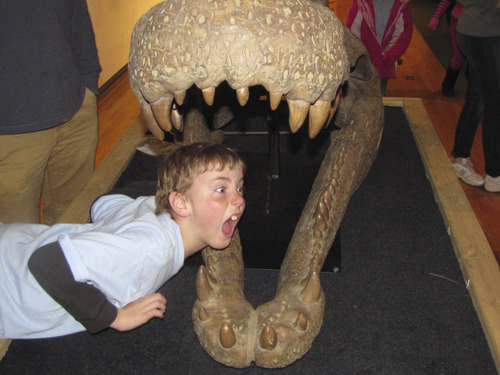This is an archived article that was published on sltrib.com in 2011, and information in the article may be outdated. It is provided only for personal research purposes and may not be reprinted.
Tropic • About 75 million years ago, much of southern Utah was covered by an inland sea. Dinosaurs roamed its shores, fed on tropical vegetation and drank from swampy bogs, which could be fatal.
Lurking just beneath the water's surface was Deinosuchus, one of the largest alligators that ever lived, which could snatch and eat dinosaurs as large as hadrosaurs (duck-billed dinosaurs) and Tyrannosaurus rex.
A cast of a Deinosuchus skull was unveiled Tuesday at Bryce Valley High School in Tropic, where about 150 students from kindergarten through 12th grade marveled at the huge fossil unearthed in 2006 at neighboring Grand Staircase-Escalante National Monument.
The replica is part of a traveling exhibit assembled by the U.S. Bureau of Land Management, which oversees the 1 million-acre monument in southern Utah's Kane and Garfield counties.
The skull eventually will travel to other schools before finding a permanent home at the new Utah Museum of Natural History in Salt Lake City, probably in November.
"It was the biggest and baddest predator of its day," said BLM paleontologist Alan Titus, who helped haul the skull from where it was found beneath a ledge on Kaiparowits Plateau.
He said dating the ash of a nearby volcano proved the alligator lived 75 million years ago during the Late Cretaceous Epoch.
It's difficult to envision an alligator living in the current landscape of southern Utah. But fossilized plants and ferns that grow only in tropical climates are found everywhere across the monument, indicating the area was once a steamy swamp.
"It was global warming on steroids," Titus said.
The Deinosuchus was the first alligator found in Utah. The skull is about 6 feet long and belonged to a creature about 30 feet long that was able to take down 6,000-pound prey. It was pieced together based on other fossils of the reptile found in Texas and took nearly five years to clean and study.
Mike Getty, collections manager at the Utah Museum of Natural History, told the young Tropic audience that the state is fortunate to have such rich boneyards of dinosaurs. Many of the fossils are displayed in Utah and attract attention from scientists around the world.
Once the replica was unveiled, students swarmed the stage and ran their fingers along its huge teeth, stuck their heads in its open jaws and threaded their arms through its nostrils.
Carlos Barcelo, a 9-year-old fourth-grader who traveled from nearby Antimony Elementary School with his class, was impressed.
"It's cool. … I like its big teeth," he said.
Cameron Cowan 9, of Tropic, was surprised to learn the creature once lived in Utah.
"It's pretty awesome," he said. "I never knew anything like this [existed] here."
Bryce Valley High School Principal Jeff Brinkerhoff said he was approached by the BLM several weeks ago with a plan for exhibiting the skull.
"It's good for them to see something that old and big that they can get right next to," he said.





